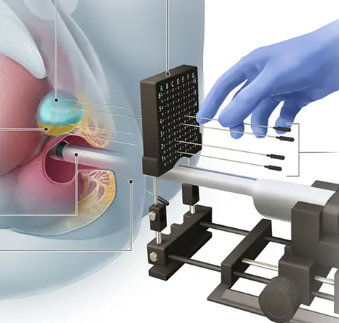Index
Introduction
When it comes to men’s health, the prostate is an organ that often comes into focus, especially due to conditions such as benign prostatic hyperplasia and prostate cancer. In this context, the transperineal prostate biopsy stands out as an important procedure, used to identify the presence of cancer cells in the prostate gland.
In this article, we will explore this procedure in detail, from its nature to the benefits and risks involved in its execution.
What is a Transperineal Prostate Biopsy?
A prostate biopsy is an invasive test performed to remove tissue samples from the prostate, which are then examined under a microscope to detect the presence of cancer. There are different methods for conducting a prostate biopsy, and the transperineal method is one of them.
The term “transperineal” refers to the access route to the prostate during the procedure. In this case, needles are inserted through the skin between the scrotum and anus (the area known as the perineum) to reach the prostate and collect tissue samples. The transperineal biopsy is performed under general or spinal anesthesia and usually uses the assistance of a transrectal ultrasound probe to guide the insertion of the needles.
Why is the Transperineal Prostate Biopsy Important?
Prostate cancer is one of the most common cancers among men. Although blood tests, such as the PSA test, can raise suspicions of prostate cancer, only a biopsy can confirm the diagnosis.
The transperineal biopsy has the advantage of being less prone to urinary tract infections compared to the transrectal biopsy, as it avoids needle passage through the rectum, which contains bacteria that can cause infection. Additionally, this method may be more suitable for some patients, such as those who have had previous rectal or prostate surgery, or those with a narrow rectum.
What Will Be Covered in This Article?
In this article, we will address the following topics:
- What is the prostate and what are the common conditions that can affect it? Understanding the anatomy and function of the prostate is the first step in understanding the diseases that can affect it and the procedures used to diagnose and treat these conditions.
- How is the transperineal prostate biopsy procedure performed? We will provide a detailed step-by-step guide on how the procedure is carried out, from the necessary preparation before the procedure to what happens during and after the biopsy.
- What are the possible risks and complications? Like any invasive procedure, the transperineal prostate biopsy has potential risks and complications. We will discuss what these risks are and how they are managed.
- Recovery and results: what to expect after the procedure? Recovery from a transperineal prostate biopsy is generally quick, but there may be some side effects. We will discuss what you can expect after the procedure and how the results are interpreted.
- Frequently asked questions about the transperineal prostate biopsy: We will answer some of the most common questions patients have about the procedure.
Our goal with this article is to provide clear and understandable information about the transperineal prostate biopsy so that you can feel more informed and confident when discussing this procedure with your doctor. Although this article is informative, it does not replace professional medical advice. Therefore, if you have any health concerns or questions about the transperineal prostate biopsy, we recommend that you consult a urologist.
We invite you to continue reading and explore further the topic of the transperineal prostate biopsy. Knowledge is one of the best tools we have when it comes to making informed decisions about our health.
What is the Prostate?
The prostate is a small gland of the male reproductive system with notable importance for men’s health. Located below the bladder and in front of the rectum, this gland performs vital functions related to reproduction and the urinary system.
Anatomy and Function of the Prostate
In terms of anatomy, the prostate is about the size of a walnut in young men but can grow over time. It surrounds the urethra, the canal that carries urine from the bladder to the outside of the body.
Regarding its function, the primary task of the prostate is to produce part of the seminal fluid, which nourishes and transports the sperm produced in the testicles. This fluid, which makes up about 30% of the semen volume, helps to protect the sperm and increase their mobility, which is essential for fertilization.
Common Prostate Problems
Although it is a small gland, the prostate can be affected by various medical conditions. We will briefly discuss three of the most common:
Benign Prostatic Hyperplasia (BPH): Also known as benign enlargement of the prostate, this condition occurs when the prostate cells begin to multiply, leading to an increase in gland size. This can cause uncomfortable urinary symptoms, such as frequent need to urinate, difficulty starting urination, and a sensation of incomplete bladder emptying.
Prostatitis: Prostatitis is an inflammation of the prostate, which can be caused by various conditions, including bacterial infections. Symptoms can vary but often include pain or discomfort in the pelvic region, urination issues, and sometimes flu-like symptoms.
Prostate Cancer: This is one of the most common forms of cancer among men. Prostate cancer usually grows slowly and initially remains confined to the prostate, where it may not cause serious harm. However, some types are more aggressive and can spread quickly.
Although these problems are common, it is important to remember that having one or more symptoms associated with these conditions does not necessarily mean you have a prostate disease. If you are experiencing symptoms, it is important to talk to a doctor, preferably a urologist, so that an accurate diagnosis can be made.
What is a Transperineal Prostate Biopsy?
A prostate biopsy is a medical procedure that involves collecting tissue samples from the prostate for microscopic analysis. It is a fundamental tool in diagnosing prostate cancer and other prostate conditions. There are different methods of prostate biopsy, one of which is the transperineal method.
Transperineal Biopsy Procedure
In a transperineal biopsy, tissue samples are collected through the perineum, the area of skin between the scrotum and anus. The procedure is performed under general or spinal anesthesia, which means you will be asleep or your lower limbs will be numb during the procedure.
The transperineal biopsy is usually carried out in a hospital or specialized clinic. During the procedure, the patient lies on their back with their legs raised and supported in stirrups. The perineal area is then cleaned, and an anesthetic gel is applied.
The doctor, usually a urologist, inserts an ultrasound probe through the rectum to obtain images of the prostate. This probe helps the doctor locate the prostate and guide the needles that are used to collect the tissue samples.
The needles are inserted through the skin of the perineum and directed towards the prostate. Several tissue samples are collected from different areas of the prostate to ensure that any cancer cells present are detected. The exact number of samples collected can vary, but it is generally between 10 to 12.
When is Transperineal Biopsy Recommended?
A transperineal prostate biopsy may be recommended when there are suspicions of prostate cancer. These suspicions can arise from various factors, such as an increase in PSA (Prostate-Specific Antigen) levels in the blood, an abnormal rectal exam, or the presence of urinary symptoms.
This biopsy method may also be recommended for men who have an increased risk of infection or who have an anatomy that makes transrectal biopsy difficult or impossible.
Advantages and Disadvantages of Transperineal Biopsy
There are several advantages to performing a transperineal prostate biopsy. One of the main ones is that it has a lower likelihood of causing urinary tract infections compared to the transrectal biopsy. This is because the needle does not pass through the rectum, which contains bacteria that can cause infections.
Another advantage is the greater accuracy in collecting tissue samples. The transperineal approach allows more direct access to the prostate and ultrasound visualization, which enhances the doctor’s ability to collect samples from all areas of the gland, including the anterior part, which is difficult to reach with the transrectal biopsy.
Additionally, the transperineal biopsy may be more suitable for men with very large prostates or with a history of previous pelvic surgeries. In these cases, accessing the prostate through the transrectal approach may be more challenging.
However, there are some disadvantages to the transperineal biopsy. One is the need for general or spinal anesthesia, which increases the risks associated with the procedure and requires the presence of an anesthesiologist. This also means that recovery may take longer, as the patient needs to be monitored after the procedure until the effects of the anesthesia wear off.
Another disadvantage is that the transperineal biopsy can be more painful than the transrectal biopsy, especially at the needle insertion site. However, this can be managed with pain medication, and most patients recover quickly.
Comparison with Other Biopsy Methods
Transrectal biopsy is the most common method of prostate biopsy and, as the name suggests, involves the insertion of needles through the rectum. Although it is a less invasive procedure and usually does not require general anesthesia, it has a higher risk of infection and may not be able to collect samples from all prostate areas as effectively as the transperineal method.
On the other hand, transurethral biopsy, which involves the insertion of a thin, flexible tube (cystoscope) through the urethra, is rarely used today for detecting prostate cancer, as it is a more invasive procedure and has a higher likelihood of causing complications.
In summary, the choice of prostate biopsy method depends on a variety of factors, including the individual characteristics of the patient, the doctor’s preferences, and the availability of resources. It is important to have an open and informative discussion with your doctor to determine the best option for you.
How is the Procedure Performed?
The transperineal prostate biopsy is a procedure that requires careful preparation and meticulous attention to each step. Here is a detailed overview of how the procedure is performed, from preparation to recovery.
Preparation for the Procedure
To ensure that the procedure is conducted safely and effectively, proper preparation is crucial. Before the biopsy, your doctor will inform you about what to expect, how to prepare, and the potential risks and benefits of the procedure.
Part of the preparation involves providing a complete medical history to your doctor, including information about any medications you are taking. Some medications, such as blood thinners, may increase the risk of bleeding during the biopsy and may need to be temporarily discontinued.
You may be asked to perform a bowel cleanse the night before the procedure. This might involve using an enema or an oral laxative.
Additionally, you will be instructed to fast (not eat or drink) for a specific period before the procedure, usually 6 to 8 hours. This is necessary because the procedure is performed under anesthesia.
During the Procedure
On the day of the procedure, you will be taken to the operating room and placed on a table, usually lying on your back with your legs raised and supported in stirrups. You will receive anesthesia to ensure that you are comfortable and do not feel pain during the biopsy.
Once the anesthesia has taken effect, the doctor will begin the procedure. An ultrasound probe is inserted through the rectum to help locate the prostate and guide the needles that will be used to collect the tissue samples.
The needles are then inserted through the skin of the perineum and directed towards the prostate. Typically, several tissue samples are collected from different areas of the prostate. This helps to ensure that any cancer cells that may be present are identified.
The biopsy procedure itself usually takes about 20 to 30 minutes. However, the total time you will spend in the clinic or hospital will be longer, as it also includes preparation for the biopsy and recovery from anesthesia.
After the Procedure
After the biopsy, you will be taken to a recovery room where you will be monitored as the effects of the anesthesia wear off. You may experience some discomfort or pain at the biopsy site, but this can usually be managed with pain medication.
Most men are able to go home on the same day of the procedure, but you will need someone to drive you home, as you may be drowsy or weak after the anesthesia. It is common to feel tired or have some perineal discomfort or hematuria (blood in the urine) after the procedure, but these effects typically subside within a few days.
Your doctor will provide specific instructions on what to expect and how to care for yourself after the biopsy. This may include guidelines on activities to avoid, such as lifting heavy objects or engaging in strenuous exercise, and symptoms that should be reported to your doctor, such as fever, chills, excessive bleeding, or difficulty urinating.
The tissue samples collected during the biopsy will be sent to a laboratory for analysis. The results are usually available within one to two weeks. Your doctor will discuss the results with you and plan the next steps, if necessary.
What are the Possible Risks and Complications?
Like any medical procedure, the transperineal prostate biopsy has its risks and potential complications. It is essential that patients are aware of these possible issues before deciding to undergo the procedure.
Risks Associated with Anesthesia
As the transperineal prostate biopsy is generally performed under general or spinal anesthesia, there are risks associated with anesthesia. Although adverse reactions are rare, they can include breathing problems, allergic reactions to the medications used, and in rare cases, cardiac complications.
Bleeding and Infection
There is a small risk of bleeding after the biopsy. This may manifest as blood in the urine, feces, or semen. Generally, this is temporary and should resolve within a few weeks.
There is also a risk of infection following the procedure. Although the infection rate is generally lower for transperineal biopsies than for transrectal biopsies, it is still a possibility. Signs of an infection may include fever, chills, and persistent pain at the biopsy site.
Difficulty Urinating
Some men may have difficulty urinating after a prostate biopsy. Although this is usually temporary, in some cases, a catheter may be needed to help empty the bladder.
Erectile Dysfunction and Temporary Infertility
Although rare, there is a risk of erectile dysfunction after a prostate biopsy. However, this is usually temporary and tends to improve over time.
Men may also notice that their semen is brown or pink after the biopsy due to the presence of blood. This is normal and should resolve over time. However, during this period, men may be temporarily infertile.
Reaction to Contrast Material
In some cases, a contrast material may be used during the procedure to help visualize the prostate. Although rare, some people may have an allergic reaction to this material.
Every patient is unique, and therefore, the response to a procedure like the transperineal prostate biopsy can vary. It is important to discuss all concerns with your doctor before the procedure to ensure that you are well informed about the possible risks and complications.
Recovery and Results
The transperineal prostate biopsy is a minimally invasive procedure, but it still requires a period of recovery. This period can vary from person to person, depending on various factors, including the individual’s overall health, the presence of any underlying medical conditions, and the individual response to the procedure.
After the Procedure
After the biopsy, you will likely be monitored for a short period before being released to go home. As you may be drowsy from the anesthesia, it is recommended that you have someone to drive you home.
It is normal to experience some perineal discomfort and to have a small amount of blood in your urine or feces after the biopsy. You may also notice blood in your semen. These effects generally diminish and disappear within a few weeks.
Your doctor will provide specific instructions on how to take care of yourself at home after the procedure. Generally, you may be advised to avoid strenuous activities and lifting heavy objects for a period of time. You may also be instructed to take antibiotics to prevent infection.
Interpreting the Biopsy Results
The tissue samples collected during the biopsy will be sent to a laboratory for analysis. A pathologist will examine the samples under a microscope to check for the presence of cancer cells. The results are usually available within one to two weeks.
The biopsy results can be normal (negative for cancer), inconclusive, or may show the presence of cancer cells (positive for cancer).
If cancer cells are found, the pathologist will assign a Gleason score to the cells. This score ranges from 6 to 10 and indicates how aggressive the cancer is. A lower score means the cancer is less likely to grow and spread quickly, while a higher score indicates a more aggressive cancer.
Your doctor will discuss the results with you when they are available. If cancer is detected, you will discuss treatment options, which may include active surveillance, surgery, radiation therapy, cryotherapy, hormone therapy, chemotherapy, immunotherapy, or a combination of these.
Frequently Asked Questions
All the information relating to a medical procedure can seem overwhelming, especially when it involves something as significant as a prostate biopsy. Here, we try to answer some of the most common questions about the transperineal prostate biopsy.
Is the procedure painful?
The procedure is performed under anesthesia, so you should not feel pain during the biopsy. After the procedure, you may experience some discomfort, which can usually be managed with pain medication.
How long does the procedure take?
The procedure itself usually takes about an hour. However, you should allow additional time for preparation before the procedure and for recovery afterward.
When can I resume my normal activities?
This varies from patient to patient, but generally, you can resume your normal activities within a few days after the biopsy. You should avoid strenuous activities and heavy lifting for a period of time after the procedure, as advised by your doctor.
Are there alternatives to the transperineal prostate biopsy?
Yes, there are alternatives, including the transrectal prostate biopsy and the perineal prostate biopsy. Each method has its own advantages and disadvantages, and the most suitable method for you will depend on various factors, including your overall health and the clinical suspicion of prostate cancer.
How accurate is the transperineal prostate biopsy?
The transperineal prostate biopsy is a highly accurate method for diagnosing prostate cancer. However, no test is 100% accurate, and there are cases where prostate cancer may be missed in a biopsy. If you continue to have concerning symptoms or if your PSA continues to rise after a negative biopsy, your doctor may recommend repeating the biopsy or undergoing other tests.
What does a Gleason score mean?
The Gleason score is a system used to grade the aggressiveness of prostate cancer. A lower score (6) indicates a less aggressive cancer, while a higher score (9-10) indicates a more aggressive cancer that is more likely to grow and spread quickly.
Conclusion
The transperineal prostate biopsy is an effective and safe method for diagnosing prostate cancer. This procedure allows the urologist to obtain prostate tissue samples for examination under a microscope, providing detailed analysis that can detect the presence of cancer cells.
The prostate is a vital part of the male reproductive system, playing a crucial role in semen production. Understanding the importance of this gland and being aware of the common health issues that can affect it is essential for maintaining male health. Prostate cancer is one such potential issue, being the second most common cancer among men worldwide.
Understanding what involves a transperineal prostate biopsy can alleviate some of the concerns you may have about the procedure. Knowing what to expect before, during, and after the procedure, as well as being aware of the potential risks and complications, can help prepare you for the experience and make informed decisions about your health.
Recovery from the biopsy is usually quick, with most patients being able to resume their normal activities within a few days. The results of the biopsy will provide valuable information that will help your doctor determine the best course of treatment for you, should cancer cells be found.
If you still have questions or concerns about the transperineal prostate biopsy, do not hesitate to contact our office. We are here to help and provide you with the care and information you need to make informed decisions about your health.
Your health and well-being are our highest priority, and we strive to provide the highest level of urological care. With our expertise and commitment to excellence, you can be assured that you are in good hands.




